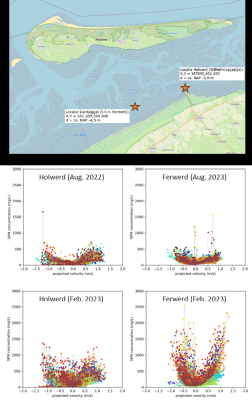Q. Bi1* and T. van Kessel1
1 Marine and Coastal Systems, Deltares, The Netherlands
* Corresponding author: qilong.bi@deltares.nl
Introduction
Sediment dynamics in the Wadden Sea are steered by a complex interplay of natural processes, but may also be influenced by human activities (Elias et al. 2012; Vonhögen-Peeters et al., 2013). In July 2022, a long-term monitoring campaign was launched to collect comprehensive data on turbidity, tidal currents, wind, waves, and salinity in the tidal channels near Holwerd and Ferwerd. By comparing an undisturbed system at Ferwerd with a human-impacted system with intensive shipping and dredging at Holwerd, we aim to identify and quantify the influences of multiple natural forcings and human activities on the local sediment dynamics. The goal of this data analysis is to deepen our insight into the suspended sediment dynamics within the system, providing a clearer picture of contributions of both natural and anthropogenic factors.
Objective and Methods
The initial analysis of these datasets involves several steps. The first step is a check on the data quality and usability. The next step is to apply various techniques, such as seasonality analysis and multivariate analysis, to explore the relationships among the measured parameters and inspect the importance of natural and human factors on the turbidity at different time scales. Furthermore, by combining data on ferry operations and maintenance dredging in the Holwerd channel and comparing the findings from two locations, their distinct environmental features are uncovered.
Results
The analysis shows that at both locations, short-term variations in the suspended sediment concentrations (SSC) are strongly controlled by variations of the local flow velocity and wave height. In the longer term, SSC also show seasonal changes (higher in winter and lower in summer, see Figure 1), which can only be partly explained by seasonal variations in physical forcing (notably wind and waves, salinity, and temperature). For similar physical conditions, the relation between bed shear stress and SSC is different in summer than in winter. This may be explained by variations in the availability and properties of fine sediments, suggesting the influence of biological activity and variations in mudflat stability. Furthermore, the comparison reveals that the SSC at Ferwerd is slightly lower in summer and higher in winter than that at Holwerd. At Ferwerd the channel is deeper and there is no local human disturbance. Seasonal dynamics are more pronounced, suggesting a greater variation in the supply and properties of sediments and a greater influence of organic material. Finally, the impact of the ferry and dredging on SSC levels at Holwerd is not evident from the data. Although occasional matches between peak SSC and human activities are observed, the correlation is not statistically significant. The mean of the measured SSC is approximately the same during periods with and without disturbance. However, this impact may still occur on a longer time scale, and might then result in a general increase in the background concentration. This requires further research on longer data sets as monitoring at Holwerd and Ferwerd continues in 2024.
In conclusion, the proposed methodology for analyzing long-term measurement data at Holwerd and Ferwerd is demonstrated effective. Insights are gained by evaluating both natural and anthropogenic factors at the two sites, but limitations of the current dataset are also noticed, which highlight the need for continuing and improving the monitoring. Because of the identified importance of variations in sediment properties and availability, it is recommended to make additional measurements on suspended particle properties such as size, settling speed and organic composition, and to add a second measuring frame on the nearby tidal flats to better distinguish between horizontal and vertical transport processes. As observations continue this year, this analysis will be further extended.
Acknowledgement: we thank Rijkswaterstaat (RWS) for their financial support, data provision, and review of this study.

Figure 1. Monitoring locations and SPM concentration against velocity at Holwerd and at Ferwerd in August 2022 and in February 2023.
References
Elias, E., Spek, A., Wang, Z., & Ronde, J. (2012). Morphodynamic development and sediment budget of the Dutch Wadden Sea over the last century. Netherlands Journal of Geosciences - Geologie en Mijnbouw, 91, 293 - 310.
Vonhögen-Peeters, L. M., van Heteren, S., Wiersma, A. P., de Kleine, M. P., & Marges, V. C. (2013). Quantifying sediment dynamics within the Dutch Wadden Sea using bathymetric monitoring series. Journal of Coastal Research, (65), 1611-1616.










